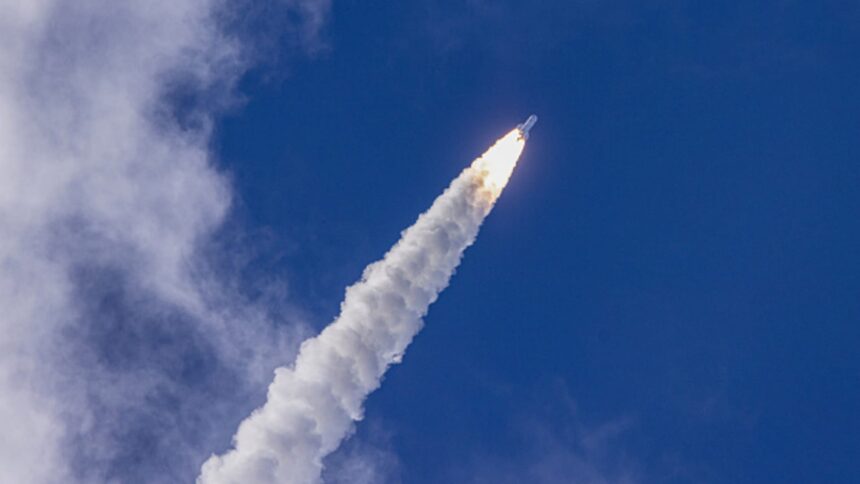This photo shows the lift-off of the Ariane 6 satellite of the European Space Agency (ESA) from the launch pad, at the Guyana Space Center in Kourou, French Guiana, on July 9, 2024.
Jody Amiet AFP Getty Images
The powerful European-built Ariane 6 rocket made its long-awaited liftoff on Tuesday, as the region returned to a launch market dominated by Elon Musk’s SpaceX.
Ariane 6, more than 200 feet tall and powered by a Vulcain engine and a pair of boosters, launched from Kourou in French Guiana at 3 p.m. ET and then successfully reached orbit.
The rocket is a joint effort of about $4.5 billion overseen by the European Space Agency (ESA) and built by ArianeGroup – a joint venture of Airbus and Safran. Thirteen countries contributed to the Ariane 6 program.
This photo shows the lift-off of the Ariane 6 satellite of the European Space Agency (ESA) from the launch pad, at the Guyana Space Center in Kourou, French Guiana, on July 9, 2024.
Jody Amiet AFP Getty Images
It is the latest in a line of European rockets dating back to the 1970s, and succeeds the Ariane 5, which was launched 117 times until it was retired last year. Ariane 6 comes in two versions: Ariane 62, with two solid rocket boosters that can send as much as 10,000 kilograms of cargo to low earth orbit (LEO); and Ariane 64, model with four solid rocket boosters capable of carrying up to 21,000 kilograms to LEO.
In the launch market, Ariane 6 falls into the “heavy” rocket class.
Ariane 6’s debut flight is a demonstration mission for ESA, and will carry a variety of small satellites and spacecraft. After liftoff, the flight will last nearly three hours before completing the deployment of the 11 spacecraft, and will also include a series of key tests of the rocket’s upper stage engine.
A late debut
The European Space Agency’s (ESA) Ariane 6 satellite rocket is seen before its first launch at the Guyana Space Center in Kourou, French Guiana, on July 9, 2024.
Jody Amiet Afp | Getty Images
Ariane 6’s maiden voyage has been delayed for years, delayed by technical problems, the Covid pandemic and the war in Ukraine.
After a full-scale invasion of its neighbor, Russia suspended all European mission launches Soyuz rocket. An alternative, smaller European rocket, Vega-C, has been launched since its failed 2022 launch – and is not expected to fly again until later this year at the earliest.
Despite rising costs and long delays, European leaders continue to support the Ariane 6 program, stressing the importance of the continent having its own access to space – rather than relying on SpaceX.
But Europe has turned to SpaceX several times out of necessity, as the company enjoys a monopoly on the global launch market.
The European Space Agency’s (ESA) Ariane 6 satellite rocket moves to the launch pad before launch at the Guyana Space Center in Kourou, French Guiana, on July 9, 2024.
Jody Amiet Afp | Getty Images
SpaceX’s reusable and low-cost Falcon 9 rocket offers an alternative to the space shuttle that has been waiting for Ariane 6 to start flying. Already, high-profile ESA missions such as the EarthCARE spacecraft, the Euclid telescope, and the Galileo satellite have been launched on SpaceX rockets.
And last month, European weather satellite operator EUMETSAT made the “extraordinary” decision to switch its upcoming satellite launch from the Ariane 6 to the Falcon 9 – a choice that drew scorn from other European officials.
“I can’t wait to know the reasons that led Eumetsat to make this decision,” Philippe Baptiste, head of the French space agency CNES, wrote in a post on social media.
“How far will we, the Europeans, be naive?” Baptiste added.
In particular, while most US companies seeking to challenge SpaceX are leaning towards reusable rocket technology, Ariane 6 is disposable like its predecessors – meaning each vehicle is the only one that is discarded after the mission.
It’s not just Europe’s desire to access its own space driving the Ariane 6 rocket have other important customers waiting for launch: Amazon. The American technology giant has ordered a staggering 97 rocket launches from five companies, nearly a fifth of which were won by Arianespace to fly the Project Kuiper internet satellite on Ariane 6.




